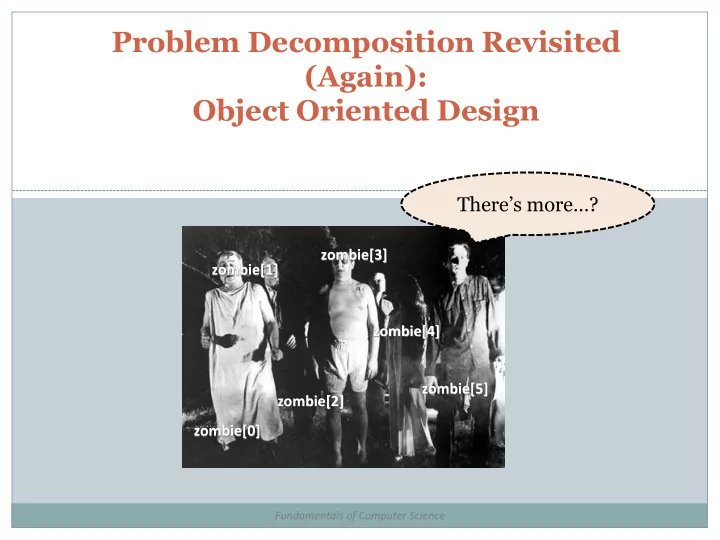

Problem Decomposition Revisited (Again): Object Oriented Design There’s more…? zombie[3] zombie[1] zombie[4] zombie[5] zombie[2] zombie[0] Fundamentals of Computer Science
Outline Object Oriented Design Identify the Classes Identify what Information each Class Needs Identify what each Class Needs to Do
Software Development Life Cycle 1. Understand the Problem = Requirements Analysis 2. Work out the Logic = Design 3. Convert it to Code = Implementation 4. Test/Debug 5. Maintenance Today we will talk about requirements analysis and object oriented design. 3
What are the Nouns? You have been hired to automate bank operations for a local credit union. They have told you that their business operates as follows: Customers can open accounts. They can make deposits and withdrawals and can close accounts also. On some accounts interest needs to be added, and sometimes fees are deducted. All employees can help customers with deposits and withdrawals. Only some employees are authorized to open and close accounts. 4
Initial Diagram 5
UML Diagram 6
UML with Some Data Types Added 7
Simplified Bank Customer: Instance Variables: Let’s ignore some of the complexity and Name assume a bank employee is running our Address program. The employee can work with SSN Customers and Accounts. Accounts Methods: For one scenario, assume a person comes Add Customer into our bank and wants to open an account. Delete Customer This person is not yet a customer, so the bank employee needs to add them as a Account: customer and then open the account for Instance Variables: them, and make that first deposit into the Balance account. Account Number Customer (By the way, this way of thinking about a Methods: problem, by looking at scenarios, is called Open Account developing use cases.) Close Account Deposit Our job is to first define the API. Withdraw Transfer Money 8
Simplified Bank Customer: Instance Variables: Our job is to first define the API. Name Address SSN What will our methods need in Accounts order to run, and what will they Methods: Add Customer return to the client program? Delete Customer Customer – Add Customer Account: Instance Variables: Delete Customer Balance Account Number Account – Open Account Customer Close Account Methods: Open Account Deposit Close Account Withdraw Deposit Transfer Money Withdraw Transfer Money 9
API Customer Customer(String firstName, String lastName, String SSN, String street, String city, String state, String zipCode) Customer DeleteCustomer() Account Account(Customer customer, long acctNumber) Account(Customer customer, long acctNumber, double initAmt) Account DeleteAccount() Deposit(double amount) Withdraw(double amount) TransferMoney(double amount, Account account) // Comment: the account parameter is the account // transferred to 10
Instance Variables Now that the API is defined, we need to make sure our instance variables are adequate to support the API. 1. What are the data types of each? 2. Do we need to refine any of them further? Customer: Name Address SSN Accounts Account: Balance Account Number Customer 11
Instance Variables Customer: String firstName String lastName String SSN String street String city String state String zipCode Account [] accounts //Comment: Let’s say a customer can have a maximum of 20 accounts Account: double Balance long accountNumber Customer customer 12
Simplified Bank Once we are happy with our class definitions, then we get to write some code!! 13
Summary Object Oriented Design Identify the classes Identify what information each class needs Identify what each class needs to do Identify use cases Define the API Define the instance variables Finally – write some code!
Recommend
More recommend